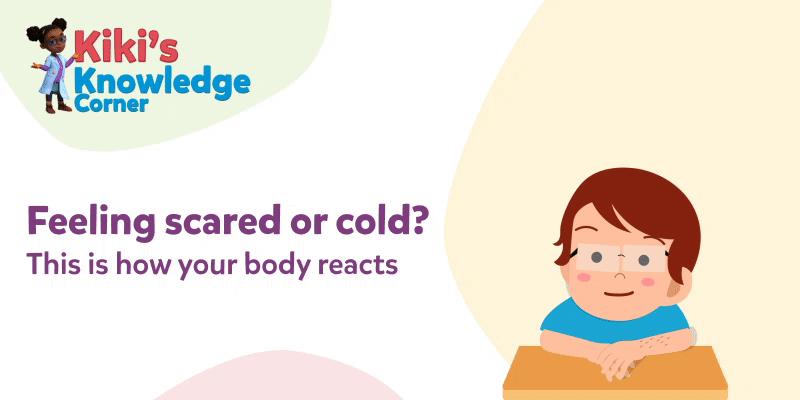Why Do We Get Goosebumps?

Hello young learners, it’s me, Kiki! Welcome back to another edition of my Knowledge Corner. I hope you had fun learning about food in our previous episode.
This time, I have a really interesting lesson for you. It’s winter now and I went outside without my sweater on. I began to feel very cold and also noticed my hair standing on their end.
This is how I got goosebumps! I put on my sweater and went home to watch a scary movie. I noticed that I got goosebumps again, especially during the really scary parts of the movie. That’s when I thought, let’s talk to my favourite young learners about goosebumps. I am sure you must be wondering: ‘Are goosebumps good or bad?’ or ‘How does our body produce goosebumps?’

This is how goosebumps look
Let’s try and get answers to all of your questions. Are you ready?
What are goosebumps?
Goosebumps are a perfectly normal reflex reaction that our body produces in response to various external factors. They are tiny bumps of skin that are formed at the base of the hair when the body reacts to factors like cold weather, fright or even a sudden unexpected touch.

When you feel cold, you get goosebumps
When you look at them, it looks like your hair is standing on their end. Here is a picture of the goosebumps on your hand. You must be wondering, why the name ‘goosebumps. Is there a connection to goose? Yes there is!
Well, if you look at a goose’s body after its feathers have been plucked, you will see many bumps on it. When our bodies react to cold or fright, our skin looks the same way. And that’s why we call it goosebumps.
How do we get goosebumps?
Like I mentioned earlier, goosebumps happen when your body reacts to conditions like cold or fright. But have you ever wondered how your body actually makes them happen?
It’s a slightly complex biological process, but I will make it easier for you to understand. Let’s imagine that you are feeling scared. What happens then is that a hormone called adrenaline gets released from the adrenal gland. When adrenaline is released, the brain sends signals to the muscles under the hair of the skin to become tense. These muscles are called arrector pili. (Say: e-reck-tor pai-lai)
When the arrector pili becomes tense, it makes the base hair stand straight. The skin under the hair then forms bumps. Goosebumps are a reflex action, triggered automatically by the body.
Did you know goosebumps helped our ancestors?
Our early ancestors (I mean the early man) were very hairy. So when they got goosebumps and their hair stood on the end, it helped them when they felt cold or were attacked by wild animals. The long hair acted like a layer of fur or wool to protect them from being cold.
And when any wild animal approached them, these long hairs on their end made the early man seem bigger, which in turn threatened the wild animals. Although our ancestors were pretty scared of the predators, this helped them escape as well!
Do animals get goosebumps?
Some mammals like cats, other furry animals and even porcupines get goosebumps. But when animals experience goosebumps, they appear significantly bigger. You may have noticed it in some animals around you.

Animals get goosebumps too
Have you seen cats seem a bit bigger with all its hair standing on the end when you touch them stealthily? That’s them having goosebumps when they are threatened and their body dealing with sudden fear.
The most obvious and scary reaction, however, would be from the porcupine. Their pointy scales become bigger and scare the opponents away. That’s fascinating, isn’t it? Do you want to try experiencing goosebumps? Try dipping your hands for a very short while in cold water. You will notice them appearing. But remember, it’s very important that you dip your hands only for a few seconds and not any longer.
Share your experience with us in the comments.
Liked this blog? Also read
Frequently Asked Questions
1. .
.